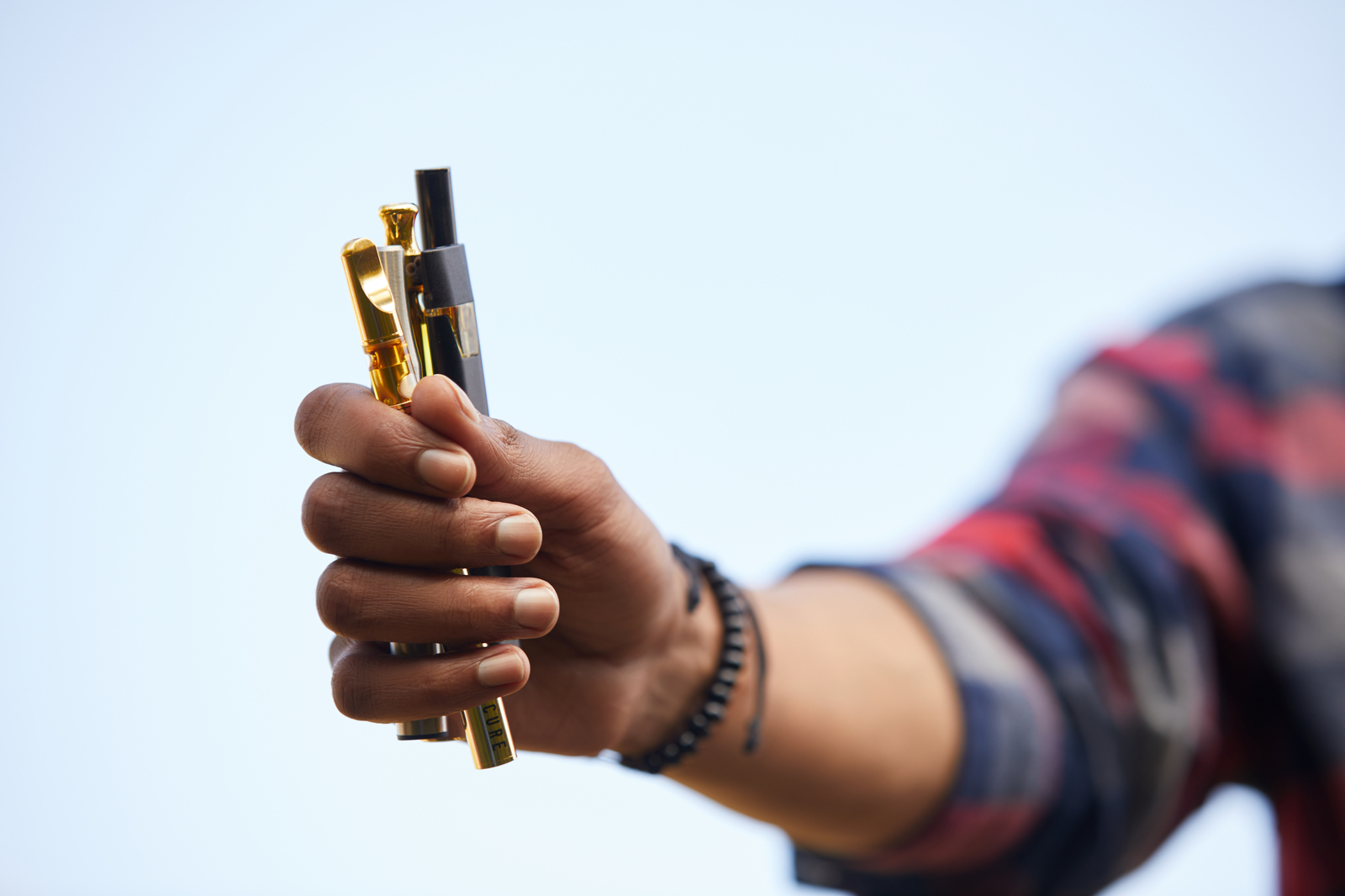Vapes. Vaporizers. Vape pens. Weed pens. Vaporinos. (OK, maybe not that last one.) No matter what you call them, the distinguishing feature of cannabis vapes is that they allow you to inhale cannabis vapor. This is also how they differ from traditional smoking devices like bongs and pipes, which allow you to inhale the smoke from burning cannabis. Similar to a smoking experience, vapor highs kick in quickly (within 15 minutes) and last anywhere from 40 minutes to two hours.
Find deals on vapes on the Weedmaps app
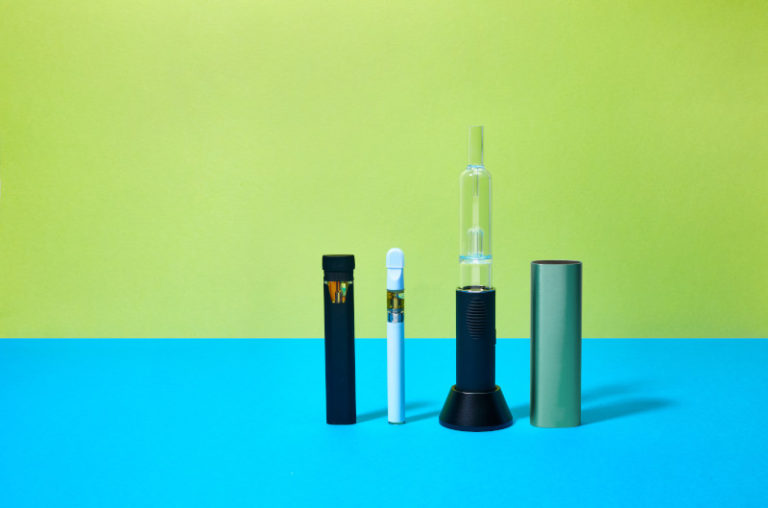 Photo by: Gina Coleman/Weedmaps
Photo by: Gina Coleman/WeedmapsImage lightbox

Vaping cannabis is easy, discreet, and arguably healthier than traditional smoking methods. But figuring out how and what you want to vape for the first time can be complicated since both flower and concentrates can be vaporized using a wide range of devices.
In this guide, you'll learn what types of vaporizers are out there, how to pick the right one for your purposes, and how to shop for safe, legal vapes.
What are vaporizers?
The process of vaping weed involves heating cannabis flower or concentrates to a temperature that turns the active cannabinoids and terpenes into vapor. Most vaporization devices are engineered to heat cannabis products just below the point of combustion, which ranges from 180 to 190 degrees Celsius (356 to 374 Fahrenheit). Compared to smoking, which can burn off many of the terpenes and minor cannabinoids present in flower, vaping cannabis can activate more of those compounds. A device with precise temperature controls can allow you to choose a temp suited to whatever cannabinoid or terpene you choose.
There are many methods by which people vaporize cannabis. The three main types are tabletop vaporizers, portable vaporizers, and vape or “hash oil” pens.
Tabletop vaporizers
Tabletop vaporizers are stationary temperature control units that require a solid surface upon which to sit. Tabletop vaporizers come in many varieties, but all include four main features:
- A temperature dial to regulate the temperature
- A healing element that heats the flower or concentrates
- A heating chamber where you put the flower or concentrates
- A mouthpiece attachment
Some tabletop vaporizers use a bag to collect the vapor, which is detached prior to inhalation. Others use a long tube that is attached to the heating chamber and allows the vapor to move directly from the heating chamber to the person using the vaporizer. Most tabletop vaporizers of this style are used to vaporize cannabis flower. Once you know how to vape weed with one tabletop vaporizer, it's very likely you'll be able to use others.
Because they function similarly, e-nail (electric nail) dab rigs could also be considered tabletop vaporizers. This device allows users to vaporize concentrates or flower using an electric nail.
Pros
- Precise temperature control
- Flexibility to use whatever flower or concentrates you want
- Reusable, minimizing packaging waste
Cons
- Not very portable
- Requires some effort to learn how to use
- Can get expensive
Portable vaporizers
Portable vaporizers are small, discreet vaporizers that operate in much the same way as tabletop vaporizers with the exception that they are, well, more portable. Portable vaporizers include a chamber to hold the cannabis flower or concentrate, a heating element, and a battery. Most portable vaporizers contain variable temperature control devices that are operated with the click of a button or turn of a small dial. This activates the battery, which heats the element and vaporizes the flower or concentrate contained within the chamber, sending it into the mouthpiece for inhalation. Portable vaporizers may not allow the same degree of heating precision as a tabletop model.
Additionally, portable vaporizers allow for easy and discreet use as the cannabis vapor creates a less potent aroma. Learning how to vape weed is generally easier than learning how to smoke it.
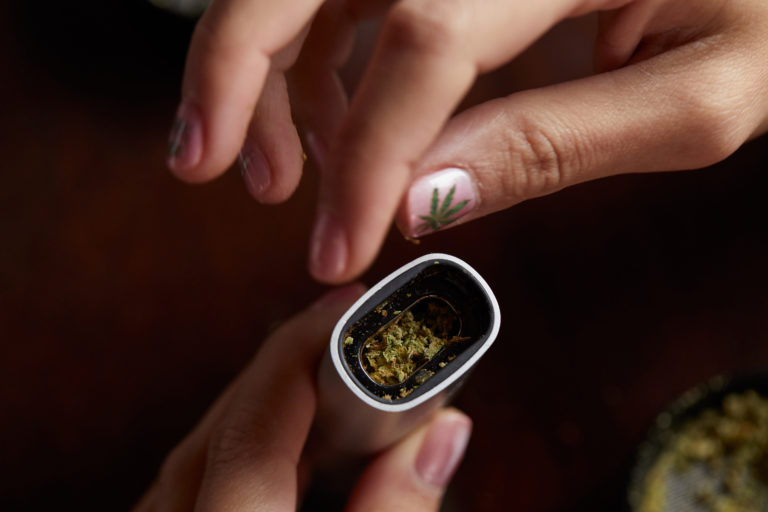 Photo by: Gina Coleman/Weedmaps
Photo by: Gina Coleman/WeedmapsImage lightbox

Depending on the device's capabilities, portable vaporizers can be used to consume many forms of concentrate including badder, budder, and shatter, as well as flower. Before purchasing a portable vaporizer, consider the ways you intend to consume cannabis and look for one designed to accommodate that product. It's important to distinguish between portable dry herb vaporizers, wax vaporizers, and hybrids. While dry herb vapes and wax vapes are designed to work with specific types of cannabis products, hybrid vaporizers like the PAX 3 offer consumers the best of both worlds as they are compatible with both flower and wax concentrates.
Pros
- Easy to use
- Portable
- Flexibility to use whatever flower or concentrates you want
- Reusable, minimizing packaging waste
Cons
- Can get expensive depending on the device
Vape pens
Vape pens, weed pens, and hash oil pens are all terms for a type of vaporizer designed specifically to vaporize cannabis distillates and oils. They are called pens because the compact design of the vape device closely resembles that of a traditional pen.
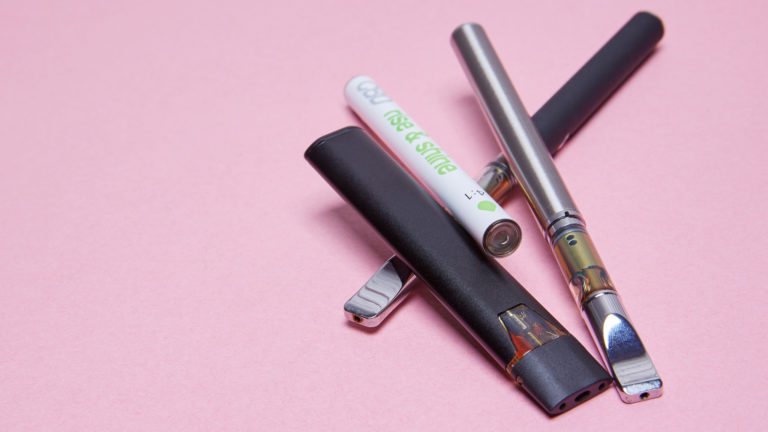 Photo by: Gina Coleman/Weedmaps
Photo by: Gina Coleman/WeedmapsImage lightbox

A reusable vape pen consists of a battery and a cartridge. Reusable vape pens are really half-reusable since you use the same battery with multiple cartridges but throw away the empty cartridge once you've vaporized all the oil inside.
Vape batteries come in a variety of styles featuring buttons or no buttons, a cylindrical shape or rectangular one, a limited or long battery life, and the ability to recharge, which means there's a battery to fit just about any personal preference. One of the most common weed pen batteries is the 510 thread, which is compatible with a large portion of the pre-filled vape cartridges on the medical and adult-use markets.
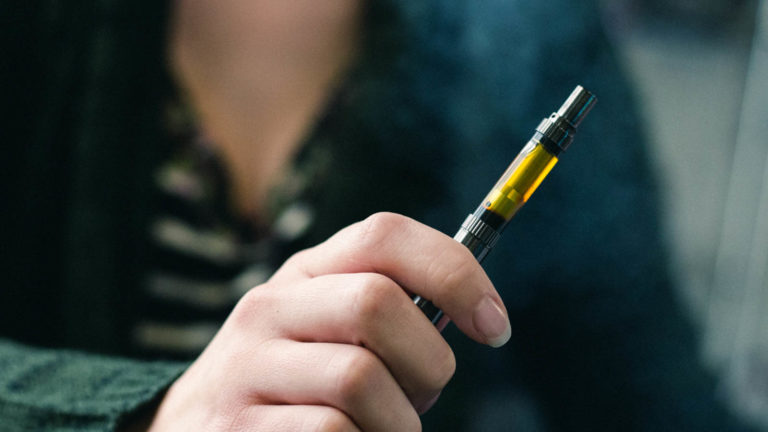 Photo by: Gina Coleman/Weedmaps
Photo by: Gina Coleman/WeedmapsImage lightbox

Vape cartridges contain a mouthpiece, chamber and heating element, which is activated by a compatible battery. The chamber of a vape cartridge is filled with oil or distillate, which contains concentrated amounts of cannabinoids and terpenes.
Disposable or all-in-one vape pens contain all the same elements of semi-reusable weed pens, but they're sealed up in one sleek, single-use package.
Pros
- Extremely easy to use
- Highly portable
- Least expensive option to try
Cons
- Partly or entirely disposable = wasteful
- Can only be used with distillate or oil cartridges
- Less flexibility in terms of strain and concentrate selection
- Can get expensive if you vape regularly
How to buy vapes safely
Vaporization can be a healthier alternative to smoking because this process occurs at relatively low temperatures. The flame from a lighter or match heats the flower to the point of combustion, and combustion can release harmful tar and carcinogens — no tobacco necessary.
More research into the long-term health effects of cannabis vaporization is needed, but there are studies backing up the perceived relative health benefits of this consumption method. A 2007 study published in Harm Reduction Journal, for example, observed self-reported respiratory symptoms in participants who used cigarettes and cannabis. The researchers found that while vaporization increased the amount of cannabis consumed, it also decreased respiratory symptoms in regular cannabis users who smoke. They concluded that the vaporization temperature was “cool enough to avoid the smoke and toxins associated with combustion.”
There's a big caveat to these potential health benefits, however. In 2019, the Center for Disease Control (CDC) made the connection between a rapid increase in lung injuries and the use of illicit vapes. The investigation into vape-related illnesses continues, but the likely causes include cutting agents like vitamin E acetate and other additives, flavorings, and generally poor-quality counterfeit products.
The takeaway for consumers: buy cannabis products from licensed brands and retailers only or risk inhaling dangerous substances. You can go the extra mile and examine an independent, third-party lab's certificate of analysis (COA) for any product you're interested in buying as well.
Frequently asked questions
What is a dab pen?
Unlike a standard vape pen, which is designed for compatibility with vape cartridges filled with oil or distillate, a dab pen is used to consume dabs, which can be defined as an unspecified dosage of concentrate. Most dab pens, also known as wax pens, are essentially made up of the same components as a vape pen: a battery and heating element. With dab pens, the concentrate is placed into the heating chamber rather than loaded into a vape cartridge in liquid form. With this type of pen, users are not limited to cartridges and can consume many forms of concentrate, including wax concentrates, badder, budder, and shatter.
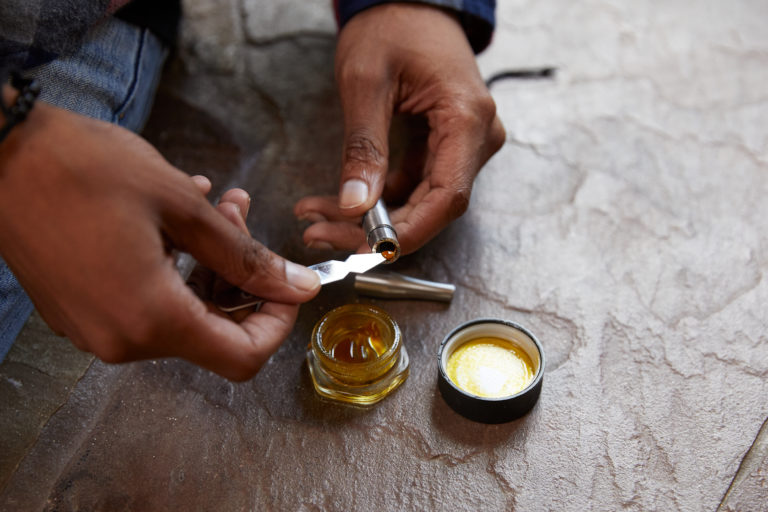 Photo by: Gina Coleman/Weedmaps
Photo by: Gina Coleman/WeedmapsImage lightbox

How much is a vape pen?
The answer depends on the quality of the vape pen and what comes with it. There are many options available on the medical and adult-use cannabis market. For example, you can find vape pen starter kits that include the battery and a device charger, disposable vape pens that come pre-filled and ready to use, and cheaper 510-thread cartridges and replacement batteries that are sold separately.
In the case of disposable vape pens that come preloaded with cannabis oil, the price will also be contingent on the location it's being sold, as the market can vary from state to state. You can sort through a massive selection of verified vape pen products from reputable brands on Weedmaps.
What's in a vape cartridge?
When choosing a vape cartridge, it's important to know what type of oil it contains, whether and how it's flavored, and if there are any cutting agents, as all these factors affect the vaping experience.
Vape cartridges are all filled with cannabis oil designed for optimal vaporization using a portable battery. During the distillation process, raw cannabis oil may be stripped of all flavor and aromatic compounds, then mixed with terpenes to reintroduce flavors, and infused with some form of glycol — polyethylene glycol (PEG), propylene glycol (PG), or vegetable glycerin — (VG) to give the vapor extra mouthfeel (thin versus thick, smooth versus chalky, dry versus buttery).
While all legal, lab-tested vape cartridges contain cannabinoids, not all cartridges contain terpenes. Terpenes are organic compounds that give plants their aroma and flavors. Raw cartridges are vape cartridges that do not contain any additional cutting agent or terpenes, just the pure cannabis oil.
The reintroduction of terpenes is common in distillate-filled cartridges, as the distillation process removes the natural plant terpenes and results in an odorless, flavorless, viscous liquid. Some extractors have mastered a technique that allows them to remove the terpenes from the plant during the distillation process and reintroduce them prior to filling the vape cartridges. These cartridges are known as strain-specific vape cartridges that use cannabis-derived terpenes to retain the same aroma and flavor of the plant that the oil was derived from.
It's also common for cartridges to be filled with naturally derived terpenes to create exotic flavors that smell and taste like fruits and candies. The reintroduction of terpenes after extraction allows manufacturers to create countless cannabinoid and terpene combinations to suit a variety of needs. These terpenes can also change the viscosity and color of the distillate in the cartridge.
Some THC vape juice contains cutting agents similar to those used in e-cigarettes, which are added to improve vape cloud production and the mouthfeel of the cartridge. The most common cutting agents include PEG, PG, and VG.
The Food and Drug Administration (FDA) has labeled these various cutting agents as safe for human ingestion, but there are still concerns about what happens when these compounds are heated and inhaled. A 2010 study published in the International Journal of Environmental Research and Public Health, concluded that inhaling PG could potentially exacerbate asthma and allergies. Additional research also suggests that, when vaporized at high temperatures, both PEG and PG break down into the carcinogens formaldehyde and acetaldehyde.
While more research is required to fully understand the effects of inhaling these cutting agents, you're best off avoiding them and shopping for raw vape cartridges.

